Recommended - Effective ways to get rid of an ingrown toenail
Taping method
While this effectively allows the skin around the toenail to heal, it does not address the underlying toenail curvature problem. Therefore, it's considered a temporary ingrown toenail pain relieving solution. This is one of the least aggressive methods to get rid of ingrown toenail pain and involves using an adhesive elastic tape. The tape is usually as thick as the height of the nail, with one end attached to the lateral nail fold beside the offending nail edge. For best results, this end should be tucked slightly into the nail fold to be able to pull the skin away more easily. The tape is then pulled taut, and should be long enough to go around the toe in an oblique manner. The other end of the tape should be able to reach the opposite nail fold but is placed obliquely so as not to cover the toenail and constrict the toe. For taping to be effective, it has to be done correctly and consistently. You may ask your doctor to teach you how to use the correct technique in applying the tape. Experts recommend that re-taping is done once to twice a week, especially if the tape has lost its stickiness.
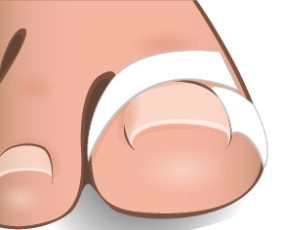
Tape being used to pull the skin away from the toenail
Orthonyxia or toenail bracing
By far the most effective method to get rid of ingrown toenails. It is the only method available that corrects the curve of the nail, the root cause of an ingrown toenail. Orthonyxia involves the use of a small corrective toenail brace, usually metal or composite, placed over the surface of the nail. If a metal brace is used, the edges are hooked on each side of the nail, then are tightened by pulling them together. This pressure aims to pull or flatten a nail that is too curved and prevent its edges from growing inward into the skin. Plastic nail braces are also available, where they are bonded to the nail surface. This helps the nail to gently grow in a less curved manner. The nail brace, when kept on for a number of weeks to a few months, can permanently correct unhealthy toenail curvature.
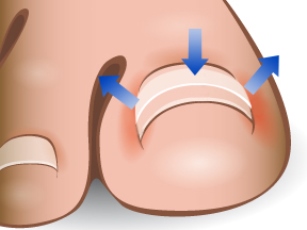
Corrective toenail brace
Not recommended - Temporary, ineffective and unhealthy ways to get rid of an ingrown toenail
Trimming off the ingrown side of the toenail
This technique is usually done by trying to dig out the ingrown edge then trimming away the ingrown side. While this may temporarily get rid of pain, it is not highly recommended since doing this merely cuts off the sharp edge but does not prevent the nail from growing in the same direction again. Also, digging out the ingrown side, especially if the skin has already been punctured, can increase the risk for infection and complications.
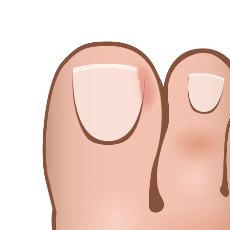
Cutting off the ingrown side of the toenail
Cotton or dental floss under the corner of the toenail
This technique involves packing a small piece of cotton or a string of dental floss under the edge of the ingrown toenail. This forces the nail up and allows the edge of the nail to be lifted out from the skin. The cotton or floss is encouraged to be changed daily, and when replaced each time, more cotton or floss may be added to attempt to raise the nail edge higher. This is performed daily until the edge of the nail is visible. This method is discouraged because permanent reshaping of the nail cannot be achieved however it may provide some temporary relief of ingrown toenail pain. It cannot be considered a long term solution.
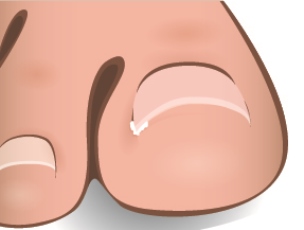
A piece of cotton or dental floss placed under the corner of the toenail
Cutting a “V” in the end of the toenail
V-cutting involves trimming the end of the nail such that a V-shape is formed at the free edge. This is said to encourage the nail to grow toward the center and prevent future instances of being ingrown. This is totally untrue since all nails grow from the base upward, thus, a V-shaped trim won’t really affect the direction your nail grows.
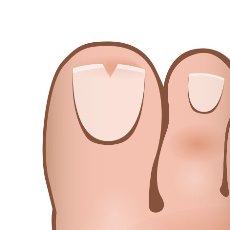
Cutting a V shape into the free end of the toenail
When not to treat at home
Chronic infection
If you observe any signs of infection near the ingrown toenail, such as a wound with oozing and drainage, swelling, pain and redness, which do not resolve even if certain home treatments have been done, it may be time to visit your doctor. Your ingrown toenail may already have progressed to a chronic infection and may have to be treated medically. Your doctor may also need to prescribe antibiotics to treat the infection.
Diabetes and poor circulation
If you have diabetes or any other condition that is associated with poor circulation, it is highly discouraged that you perform any home treatments on your ingrown toenail. Poor circulation in your legs can lessen sensations, thus, you may not have felt any pain or other bothersome sensations in your toe. This also makes you more prone to complications and progression of the ingrown nail.
